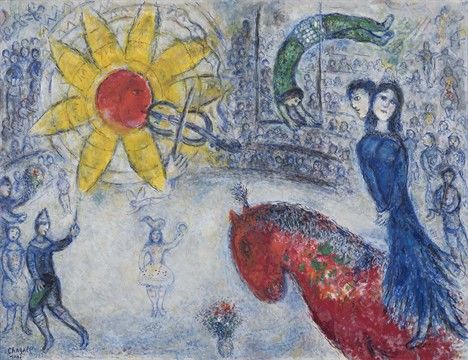Marc Chagall | Fables
4 October - 23 December 2016
Alon Zakaim Fine Art is proud to present Fables, an exhibition dedicated to the phenomenal and influential career of Marc Chagall. Featuring works spanning over six decades, the selected paintings show the artist's oeuvre to be as complex and multifaceted as the man himself. Chagall never tied himself to any single artistic movement; nor to any one place, moving between Vitebsk, St Petersburg, Paris, southern France, and New York. His work shows traces of the academic techniques he learned from Yuri Pen, and a literary sensitivity to his subject matter, yet also a startlingly modern approach to colour, composition, and technique. The artist allowed life to flow through him, captured in dazzlingly original works that remain highly influential today.
Chagall was born in Vitebsk, Russia, in 1887, to parents of modest income who were part of the Hasidic Jewish community of the town. His experiences as a youth were to leave profound traces on his artistic practice throughout his career; he attended the Jewish school, took violin and music lessons, and helped at the local synagogue. Music and religion are recurrent motifs in Chagall's work, as is the iconography of romance, and many of his works feature fiddlers, married couples, and imagery derived from Judaism and Christianity. The artist allowed new experiences to enter into his practice and develop the intensely personal narrative he was creating. In 1911, Chagall made his first journey to Paris via Berlin, a period which had a lasting impact on him. It was in Paris that he met Herwarth Walden in 1913, the owner of the influential Berlin-based Galerie Der Sturm, where Chagall had his first solo exhibition the following year. In Paris Chagall also worked alongside many of the most important artists of the period on taking a studio in a complex known as La Ruche, or The Beehive, in 1912. Here Fernand Leger, Amedeo Modigliani, Alexander Archipenko, Chaim Soutine and Ossip Zadkine also lived and worked, and the frenetic atmosphere of Paris is captured in the artist's works of the period. It was this city which allowed the artist to see, in his own words, "this revolution of the eye, this circular motion of the colours which, as Cezanne wanted, mingle at once spontaneously and consciously in a ripple of lines, or run freely, as Matisse shows." He often lived in extreme poverty, painting with whatever came to hand - he frequently bought old paintings to work over since this was cheaper than buying new canvases.

The impact of French culture on the artist was profound, and remained with him throughout his career. His work is replete with images of the capital and the colourful environment in which he found himself, yet such biographical content set the artist at odds with much of the modernist movement, which was seeking a form of painting in which the image was self-sufficient. In the words of Jean-Michel Foray, in Chagall's work "The art must have a second meaning - it must refer to something other than itself." This second meaning formed the mythology Chagall created for himself. He refused to compromise on his artistic principles, to the extent that he was ousted by Kazemir Malevich from his role as director of the Vitebsk art school in 1920 for not embracing the fashionable new abstract forms of painting. In the artist's own words, he wanted "an art of the earth, not only of the head," and abstract painting could not allow him to invest the canvases with the depth of emotions he sought to express. From the vigour of the artist's circus scenes to the tenderness of his romantic couples, the artist explored his motifs with passionate dedication and joyful energy. On his death in 1985 Marc Chagall left the legacy of a lifetime of artistic experimentation, having created thousands of pieces both inspiring in their technical proficiency and profound in their emotional impact.
Marc Chagall: Fables explores the recurrent themes of the artist's career, the range and depth of motifs he developed over a career lasting more than eighty years. This selling exhibition will run at 5-7 Dover St. London W1S 4LD from 4 October - 30 November 2016*. Entry is free and gallery opening hours are 09.00 - 18.00, Monday - Friday. Weekends by appointment only.
*This exhibition has been extended until 23 December 2016 due to popular demand!

